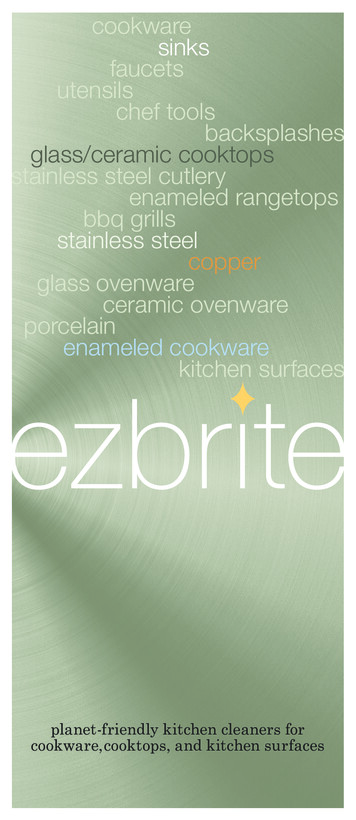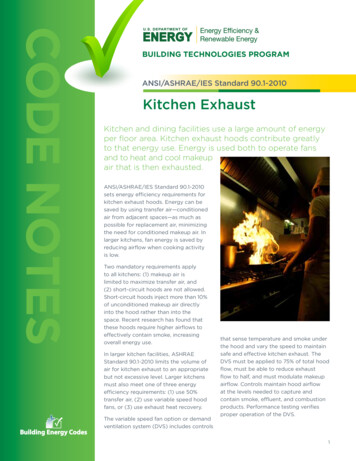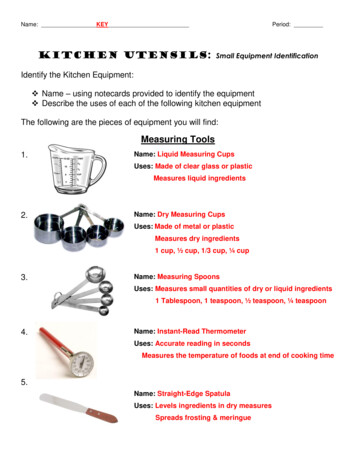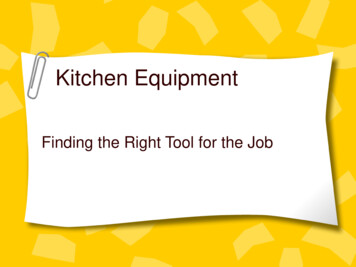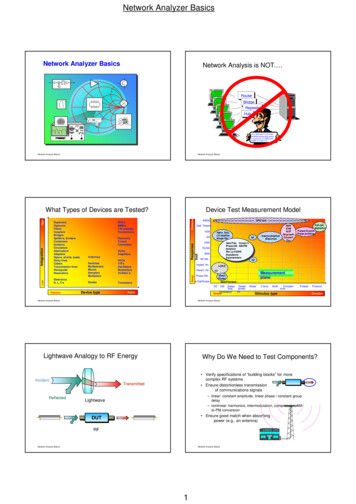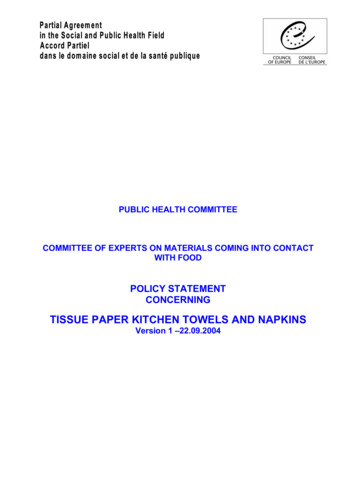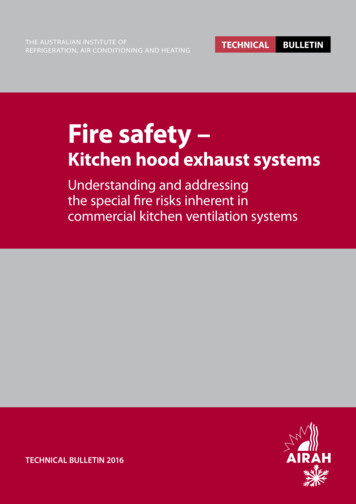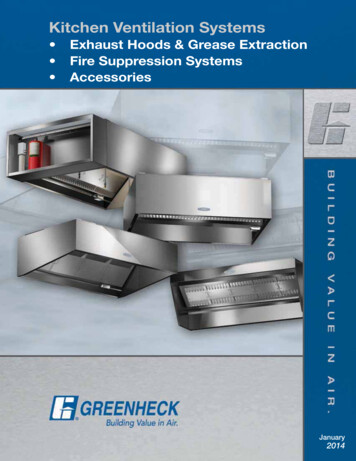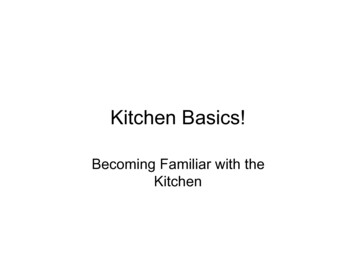
Transcription
Kitchen Basics!Becoming Familiar with theKitchen
Learning the Basics What you need to know before you cook!– Know your kitchen Work Centers Appliances, Tools, and Equipment– How to follow a recipe Cooking and Mixing Terms Measuring and Abbreviations– Personal and Food Safety– Clean Up!
Know Your Kitchen! Knowing your kitchen and tools helps youwork efficiently– Work Centers for the kitchen activities: Food Preparation and Storage– Refrigerator and cabinets for storing utensils and food Cooking and Serving– Stovetop and oven cooking and baking– Cabinets and counter for foods and tools Clean Up– Sink and dishwasher– Cabinets for storing dishes, tools, and utensils*Today kitchens may also have a planning work center witha computer, bookshelves, and desk
Kitchen Work Centers What do we do in the kitchen? Food Uses of the kitchen– Storage– Preparation– Cooking– Serving– Clean-up– Planning
Kitchen Layouts L-ShapeDouble L Design
More Kitchen Layouts U Shape PlanCorridor Plan
Kitchen Designs Goal- Is to save human energy and bemore efficient– Learn the centers in your kitchen– Keep tools in the center where they arefirst used
Cooking AppliancesCooking Methods are similar, however gas and electricappliances cook differently. Everyone has their favorite!Cooking MethodGasElectricCooktop- CookingSurfaceHeats up instantlyHigh is very hot!Takes a few minutestemperature settingsBake- In the oven bydry heatNeeds to preheat 2-3minutes per 100degreesNeeds to preheat- timergoes off when readyBroil- Cooking by direct Very hot- open flameheatadjust broiler panaccordinglyClose door but watchcarefullyHot top coils.Adjust racksaccordingly.Keep door openConvection BakeCirculates air fastbakingAdjust time accordinglyAdjust time accordingly
Microwave Ovens Always read the manual and know how to operate yourmicrowave properly.– Using and Caring for Microwaves Do not turn on a microwave when empty Use only microwave safe cookware, like glass, ceramic,plastic, and paper. Do not use metal cookware or wires ormetallic edged dishes. Clean the interior and exterior after use, including door seal– Safety Tips Always use a hot pad, dishes become hot in the microwavefrom the food. Pierce certain foods before cooking (potatoes, hotdogs) Remove cover so steam flows away form your face.
Microwave OvensUse your microwave to thaw, cook, reheat, and savepreparation time. Microwave Cooking Tips– The higher the wattage the shorter the cookingtime.– Vent one side of plastic wrap cover to allowmoisture to escape.– Standing time allows food to continue cooking.– Use paper towels to prevent spattering.– Stir during cooking time.– Foods that need to boil such as pasta, rice, andbeams will not cook faster in a microwave.
Time Saving Small le IronBlenderToasterElectric MixerRice CookerGriddleDeep FryerFood ProcessorBred MakerSlow CookerPressure CookerWhat else?
Kitchen Equipment Cooking and baking tools and utensils savetime and energy!– Make sure all utensils are durable and are easy toclean. Lean how to sue these tools for best results.––––Cutting and servingMixingBaking in the ovenCooking on the stove top
Know how to follow a recipe! It is important to know some basic cooking terms andhow to measure ingredients accurately whenpreparing foods. Most recipes list ingredients and directions in theorder that they occur. Follow a recipe step-by-step! To get good results from a recipe – Read the recipe carefully.– Get all utensils, tools, and ingredients ready.– Measure accurately.– Mix as directed.– Bake or cool the required time.
Measuring Dry Ingredients For dry ingredients including flour,sugar, and salt use dry measuringcups and spoons. Follow these steps 1. Heap2. Level3. Empty
Measuring Solid Ingredients For solid ingredients including peanutbutter, shortening, and brown sugaruse dry measuring cups. Follow these steps 1. Pack2. Level3. Empty
Measuring Liquids For liquid ingredients including milk,water, oil, and juice use liquidmeasuring cups Set cup on a FLAT surface Bend down to eye level and pour untilthe desired mark is reached.
Using Measuring Spoons Use measuring spoons to measuresmall amounts of dry and liquidingredients. Do not use kitchenspoons- they ARE NOT ACCURATE!
Abbreviations Do you understand these abbreviations?tsp. or t.Tbsp. Or T.c.pt.qt.oz.lb. or #f.g.F
Equivalents From small to large measurements:1T 3 t.1 c. 16 T.2 c. 1 pt.4 c. 1 qt.16 c. 1 gal.2 pt. 1 qt.4 qt 1 gal.
Cooking Terms Recipes use a variety of terms todescribe exactly how to handleingredients.– If a recipe states, “pare an apple, then sliceand dice it”- What do you do?
Cooking terms Just a few of the hundreds of terms: Cutting and eMinceChopSlice
Cooking Terms dStirWhipCombineStrainCut-in
Cooking Terms using thestove-top BasteBoilBraiseFrySimmerSautéBrownStir-fryPreheat
Cooking terms using the oven Bake Broil Roast Grill PreheatCooking terms using the microwave:-Cooking time -Rotate Standing time
Safety in the Kitchen A must when cooking!– Did you know that more accidents happenin the kitchen that any other room in thehouse?– Safety can be divided into 2 very importantareas: Personal Safety in the kitchen Food Safety- Preventing food borne illnesses
Personal Safety Many kitchen accidents are due to lack ofinformation or carelessness.– Chemical poisoning, cuts, burns, fires, and fallsare the most common of these accidents.– Electric shock and choking follow close behind.– You can prevent many accidents by: Properly using and caring for equipment.Noticing and correcting potential dangers.Being organized and following directions.Keeping your kitchen clean.
Food Safety Preventing Food Borne Illnesses:– A food borne illness is an illness transmitted byfood.– Millions of cases for food borne illnesses occur inthe U.S. each year. Many go unreported becausepeople mistake their symptoms for the flu.– A food borne illness can result in 1 or 2 ways: Contaminants- substances that have accidentally gotteninto the food. Bacteria- micro-organism that multiple and under certainconditions can cause people to get sick.
WAYS TO PREVENT FOODBORNE ILLNESSES: Sanitation- keep yourself and yourkitchen clean! What are the things you should bedoing before you cook for personal andkitchen cleanliness?
Microwave Ovens Use your microwave to thaw, cook, reheat, and save preparation time. Microwave Coo
